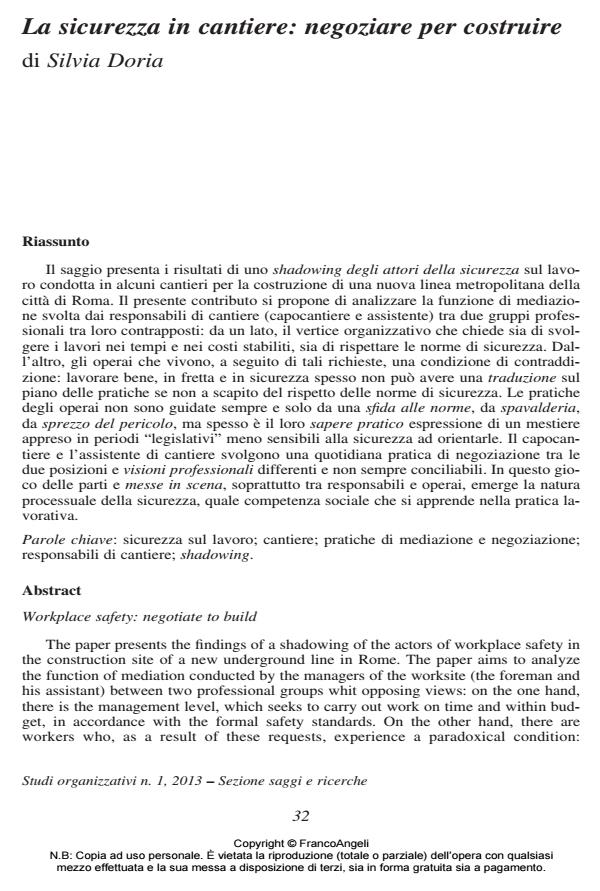Workplace safety: negotiate to build
Journal title STUDI ORGANIZZATIVI
Author/s Silvia Doria
Publishing Year 2013 Issue 2013/1
Language Italian Pages 24 P. 32-55 File size 522 KB
DOI 10.3280/SO2013-001002
DOI is like a bar code for intellectual property: to have more infomation
click here
Below, you can see the article first page
If you want to buy this article in PDF format, you can do it, following the instructions to buy download credits

FrancoAngeli is member of Publishers International Linking Association, Inc (PILA), a not-for-profit association which run the CrossRef service enabling links to and from online scholarly content.
The paper presents the findings of a shadowing of the actors of workplace safety in the construction site of a new underground line in Rome. The paper aims to analyze the function of mediation conducted by the managers of the worksite (the foreman and his assistant) between two professional groups whit opposing views: on the one hand, there is the management level, which seeks to carry out work on time and within budget, in accordance with the formal safety standards. On the other hand, there are workers who, as a result of these requests, experience a paradoxical condition: working quickly and safely can be translated in practice only going beyond the safety rules and standards. Practices of workers are based not only and not always on a willingness to challenge the rules or on a sort of cockiness, a contempt of danger, but on their practical knowledge learnt in periods in which rules were less "sensitive" to safety. The site foreman and his assistant perform a daily practice of negotiation between these two different, not always reconcilable, positions and professional views. This game of roles and performances, especially among foremen and workers, offers the opportunity to look at the constructed and dynamic nature of safety learning, a social competence that is learnt on the job. .
Keywords: Workplace safety; construction site; practices of mediation and negotiation; managers of the worksite; shadowing
- Sicurezza sul lavoro e regolazione: dalle policy alle regole del gioco situate Silvia Doria, in SOCIOLOGIA DEL LAVORO 135/2014 pp.167
DOI: 10.3280/SL2014-135010 - Lavoro temporaneo e in/sicurezza lavorativa: un approccio discorsivo Elisa Bellè, Anna Carreri, Francesco Miele, in STUDI ORGANIZZATIVI 1/2015 pp.97
DOI: 10.3280/SO2015-001005 - Il Pos: artefatti che (dis)organizzano la sicurezza Silvia Doria, in STUDI ORGANIZZATIVI 1/2015 pp.76
DOI: 10.3280/SO2015-001004
Silvia Doria, La sicurezza in cantiere: negoziare per costruire in "STUDI ORGANIZZATIVI " 1/2013, pp 32-55, DOI: 10.3280/SO2013-001002